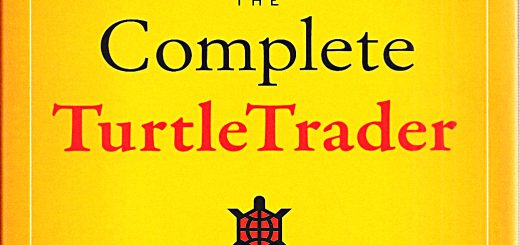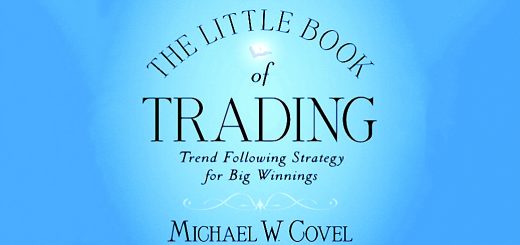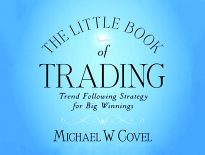The Little Book of Trading – Part 2

Today’s post is our second visit to one of the “Little Books” – Michael Covel’s Little Book of Trading.
Contents
Far Away from Wall Street – Kevin Bruce
Kevin Bruce is an example of a successful trader ($100M net worth) who works away from Wall Street – in Richmond, Virginia in his case.
- Bruce once visited a New York trading floor and found it too busy.
Everything is like a flight plan, it’s got to be pre-planned. Trying to make decisions when the market is open is going to lead to emotional decisions.
Bruce wanted to be a corporate lawyer, but his uncle who was a judge persuaded him that he wouldn’t like the 60-hour work weeks.
- Plus you have to wait a long time for the big money.
He developed his trading strategy as a graduate student in finance at the University of Georgia, as part of a (paper) trading game on agricultural futures.
- He won the game, and thought “Why not try it for real?”
- He quickly turned $5K of real money into $14K.
Michael’s central point is that:
If he lost the $5,000, he would have tried it again, because he had absolute conviction. The great trend followers do not quit.
They practice. They learn. They stick with it. Everything about Bruce’s trading is self-taught.
After graduation Bruce went to work for an Atlanta savings bank, but they were too risk-averse to let him trade his trend following style.
- So he found a smaller bank that would.
Michael says:
I have found that with all great trend following traders, games have played a crucial role.
With Bruce it was chess.
In every situation you need to think about what can go wrong and what will you do if it does go wrong? Where do you get that discipline? It can begin when you are very young.
It can begin with sports or chess or other forms of competition. You start to understand that you can only win if you’re consistent.
Think Like a Poker Player – Larry Hite
We’ve met Larry Hite before – he was one of Jack Schwager’s original Market Wizards.
- So I won’t repeat anything that was covered there.
Hite is another of the traders in Michael’s book who looks to Ed Seykota as a mentor.
Hite is all about risk management and favourable odds.
- He never risks more than 1% of his total account on any trade.
He has two basic rules:
- If you don’t bet, you can’t win.
- If you lose all your chips, you can’t bet.
There is a great connection between successfully trading and successfully playing poker. Winners think in terms of odds.
Larry Hite is famous for putting the odds on his side as a trend following trader for over three decades. That means betting big money when you have a chance to win big, and not betting big when you’re guaranteed to lose.
You have to stay supremely focused on exactly what is relevant. What information is verifiable? What can you actually know that’s not just someone’s opinion? Then if it’s verifiable, is it relevant?
You don’t swing at every pitch. You can wait for your perfect pitch.”
The first part of the winning process is evaluating who you are and what you’re comfortable doing. You have to figure out what you can do.
Could you do it again, again, and again?
Hite says:
I’ve always built in an assumption of wrongness. I always ask myself: What is the worst thing that can possibly happen in this scenario? I always want to know what I’m risking.
If you’re playing a positive expectation game, you don’t want to be knocked out. Good stuff always takes care of itself, but you have to stay alive. You can’t play if you’re dead.
There are two kinds of helicopter pilots. There are old pilots and bold pilots, but there are no old bold pilots.
There are four kinds of bets. There are bets you win and bets you lose. There are good bets and bad bets. You can win on a bad bet. You can lose on a good bet, but the point is you do a lot better on good bets.
How much money are you willing to lose on a trade? Always get out when your stop is hit.
If you never bet your lifestyle, nothing bad will ever happen to you. If you know what the worst possible outcome is, you will have tremendous freedom from stress.
You can’t quantify reward, you can quantify risk.
Stand Up, Dust Yourself Off – David Harding
David Harding struggled with trend following, but stuck with it for years until it came good.
- Michael’s lesson from this chapter is perseverance.
Harding has averaged nearly 20% a year for the last 20 years (to the time the book was published).
Harding is from London, and has a Cambridge degree in physics. (( Like me – he seems to have done a bit more with his ))
- After graduation he was drawn to technical analysis, but wanted more scientific rigour.
Harding says:
The only thing I ever wanted to be was a quantitative trader.Just like a violinist needs to play a violin, I need to take a quantitative approach to markets. I’m only interested in the maths.
Like Hite, Harding is obsessed with controlling risk.
Michael discusses how risk is not volatility.
Some calculate risk as standard deviation of return, a statistical measurement of historical volatility. It shows how much “dispersion” there is from the “average.”
But as a trend following trader you will make your money far outside the bounds of normality, in the “tail” of the bell curve.
The probability that returns will fall within three standard deviations, is 99.97% – in theory.
- But investment returns seem to have “fatter tails” in practice.
Don’t get caught up constantly trying to lower your risks. Think of yourself as running a risk targeting business where you go find risk. No risk, no reward!
Investing is a form of gambling; it is betting. They are both intellectually similar activities, but of course you should have no interest in playing a game where, according to the laws of the game, you cannot win.
If a game has a payout ratio of less than one–and gambling games have a payout ratio of less than one– it means the longer you play, the more certain you are to lose.
Harding says:
Determination is the same as having wings. If at first you don’t succeed, try, try, and try again.
Conclusions
If anything, this second visit to Michael’s book has been more frustrating / disappointing than the first.
- The book now looks like a series of character sketches used as the background to Michael’s sales pitch for trend following as the best investment strategy to follow.
Today’s lessons seem to be around perseverance and risk management.
I’m all for trend following, but the first six chapters haven’t revealed much about how to do it in practice.
- And there’s been nothing on where it might fit in for the typical private investor.
We’ll persevere, but at this point The Little Book of Trading feels like an obstacle that I have to get through before I begin Covel’s own book on Trend Following.
Until next time.















